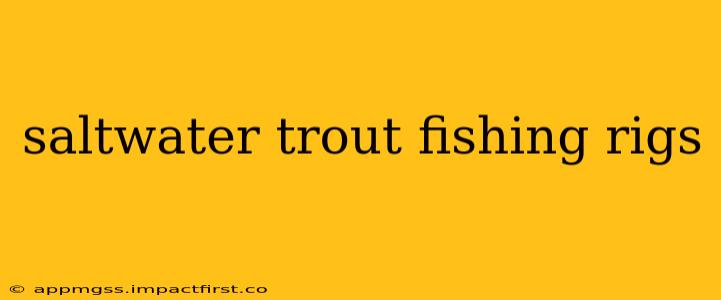Saltwater trout, with their acrobatic leaps and powerful runs, offer anglers an exhilarating challenge. Successfully targeting these prized fish requires more than just luck; it demands the right gear and techniques. Choosing the appropriate saltwater trout fishing rig is paramount to maximizing your chances of a successful catch. This guide delves into the best rigs for various situations, ensuring you're well-equipped for your next saltwater trout adventure.
What are the Best Rigs for Saltwater Trout Fishing?
The ideal rig for saltwater trout fishing depends heavily on several factors, including the target species, the fishing location (structure, current, depth), and the bait or lure you're using. However, some rigs consistently prove effective. These include:
-
Light Tackle Spinning Gear: This setup is versatile and adaptable to many situations. A sensitive rod allows you to feel subtle bites, while a smooth-spinning reel enables precise casting and control during the fight. Line weight typically ranges from 6-12lb test, depending on the size of the trout and the potential for encountering larger predators.
-
Float Rigs: Excellent for presenting baits at specific depths, float rigs are particularly useful in shallower waters or when targeting trout that are suspended in the water column. These rigs use a bobber (or float) to keep your bait at the desired depth, often in conjunction with a small weight to ensure the bait stays in place.
-
Carolina Rigs: Ideal for covering larger areas of bottom structure, the Carolina rig is effective in deeper waters where you need to present your bait at or near the bottom. This rig features a weight (usually a bullet weight) several feet above a swivel, followed by a leader and hook.
-
Texas Rigs: This weightless rig is fantastic for working lures through heavy cover, like grass beds or mangrove roots. The weightless nature allows for a more natural presentation and increased sensitivity to strikes.
What type of line is best for saltwater trout fishing?
The best line for saltwater trout fishing is a high-quality, braided line. Braided line offers superior strength, sensitivity, and low stretch, enabling you to feel even the subtlest bites and set the hook effectively. However, the diameter of the line should be carefully considered depending on the target fish size and the fishing conditions. Thinner lines allow for longer casts and a more natural presentation, while thicker lines offer more breaking strength when dealing with larger fish or strong currents. Monofilament and fluorocarbon lines also have their place, particularly for leader material to improve stealth.
What kind of hooks should I use for saltwater trout fishing?
Hook selection depends on the bait or lure you're using. For live bait, use circle hooks to minimize injury to the fish and increase hook-up rates. For artificial lures, select hooks appropriate for the lure's size and design, prioritizing durability and sharpness. It’s crucial that the hook is strong enough to handle the size of trout you anticipate catching.
What is the best bait for saltwater trout?
The best bait for saltwater trout is highly variable depending on location and season. However, some popular choices include live shrimp, small baitfish (like pilchards or mullet), and artificial lures that imitate these natural prey items. Experimentation is key to determine what works best in your specific fishing area.
What are some tips for saltwater trout fishing?
- Learn the tides: Trout are often more active during specific tidal phases. Understanding the tidal patterns in your fishing area is crucial for success.
- Target structure: Saltwater trout often hold near structure, such as oyster bars, docks, and submerged vegetation. Focus your efforts on these areas.
- Use stealth: Trout are wary, so approach them quietly and carefully.
- Practice your casting: Accurate casting is crucial for presenting your bait or lure effectively.
By understanding the different saltwater trout fishing rigs and employing these effective techniques, you can significantly enhance your chances of landing these magnificent fish. Remember to always practice responsible fishing techniques and adhere to local regulations. Tight lines!
